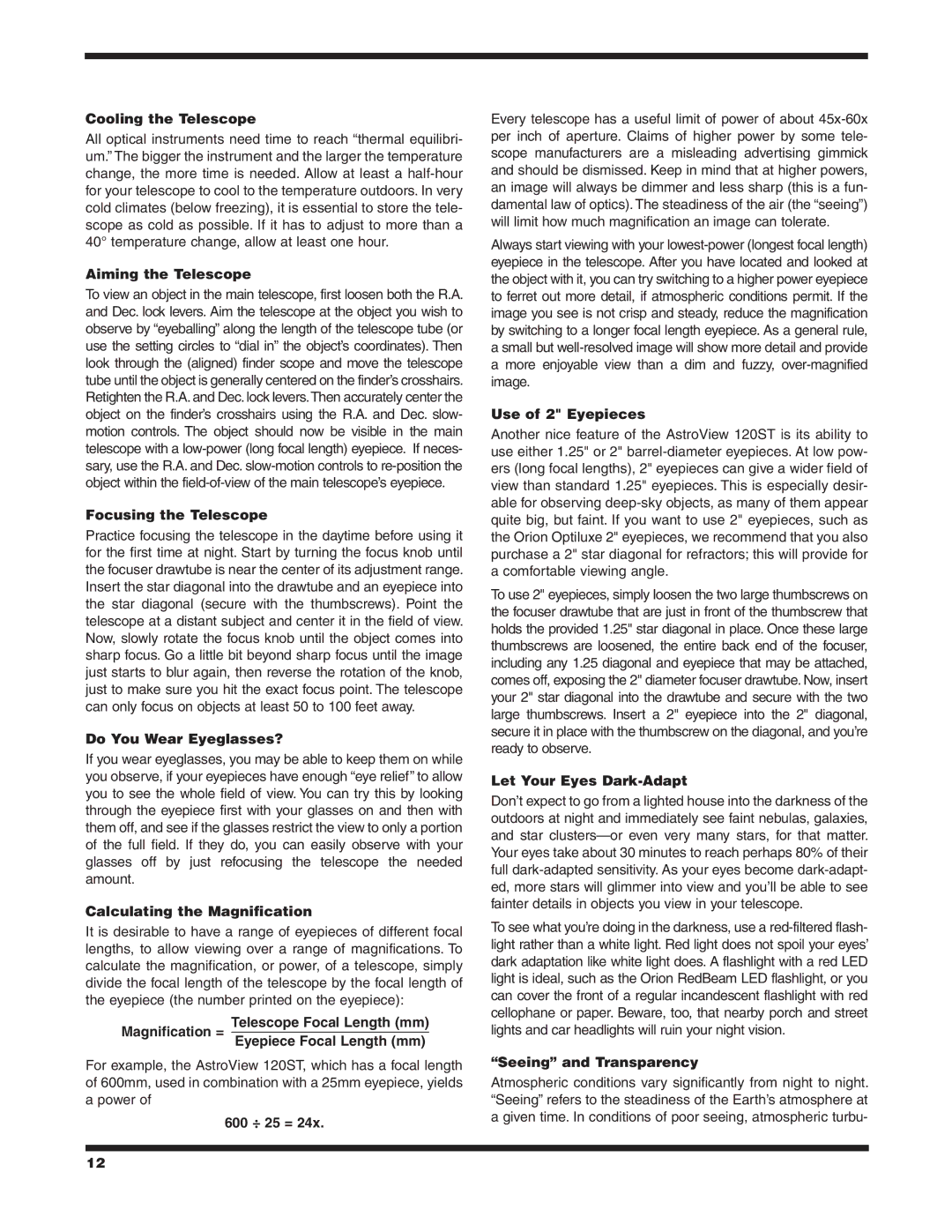
Cooling the Telescope
All optical instruments need time to reach “thermal equilibri- um.” The bigger the instrument and the larger the temperature change, the more time is needed. Allow at least a
Aiming the Telescope
To view an object in the main telescope, first loosen both the R.A. and Dec. lock levers. Aim the telescope at the object you wish to observe by “eyeballing” along the length of the telescope tube (or use the setting circles to “dial in” the object’s coordinates). Then look through the (aligned) finder scope and move the telescope tube until the object is generally centered on the finder’s crosshairs. Retighten the R.A. and Dec. lock levers.Then accurately center the object on the finder’s crosshairs using the R.A. and Dec. slow- motion controls. The object should now be visible in the main telescope with a
Focusing the Telescope
Practice focusing the telescope in the daytime before using it for the first time at night. Start by turning the focus knob until the focuser drawtube is near the center of its adjustment range. Insert the star diagonal into the drawtube and an eyepiece into the star diagonal (secure with the thumbscrews). Point the telescope at a distant subject and center it in the field of view. Now, slowly rotate the focus knob until the object comes into sharp focus. Go a little bit beyond sharp focus until the image just starts to blur again, then reverse the rotation of the knob, just to make sure you hit the exact focus point. The telescope can only focus on objects at least 50 to 100 feet away.
Do You Wear Eyeglasses?
If you wear eyeglasses, you may be able to keep them on while you observe, if your eyepieces have enough “eye relief” to allow you to see the whole field of view. You can try this by looking through the eyepiece first with your glasses on and then with them off, and see if the glasses restrict the view to only a portion of the full field. If they do, you can easily observe with your glasses off by just refocusing the telescope the needed amount.
Calculating the Magnification
It is desirable to have a range of eyepieces of different focal lengths, to allow viewing over a range of magnifications. To calculate the magnification, or power, of a telescope, simply divide the focal length of the telescope by the focal length of the eyepiece (the number printed on the eyepiece):
Magnification = Telescope Focal Length (mm)
Eyepiece Focal Length (mm)
For example, the AstroView 120ST, which has a focal length of 600mm, used in combination with a 25mm eyepiece, yields a power of
600 ÷ 25 = 24x.
Every telescope has a useful limit of power of about
Always start viewing with your
Use of 2" Eyepieces
Another nice feature of the AstroView 120ST is its ability to use either 1.25" or 2"
To use 2" eyepieces, simply loosen the two large thumbscrews on the focuser drawtube that are just in front of the thumbscrew that holds the provided 1.25" star diagonal in place. Once these large thumbscrews are loosened, the entire back end of the focuser, including any 1.25 diagonal and eyepiece that may be attached, comes off, exposing the 2" diameter focuser drawtube. Now, insert your 2" star diagonal into the drawtube and secure with the two large thumbscrews. Insert a 2" eyepiece into the 2" diagonal, secure it in place with the thumbscrew on the diagonal, and you’re ready to observe.
Let Your Eyes Dark-Adapt
Don’t expect to go from a lighted house into the darkness of the outdoors at night and immediately see faint nebulas, galaxies, and star
To see what you’re doing in the darkness, use a
“Seeing” and Transparency
Atmospheric conditions vary significantly from night to night. “Seeing” refers to the steadiness of the Earth’s atmosphere at a given time. In conditions of poor seeing, atmospheric turbu-
12
